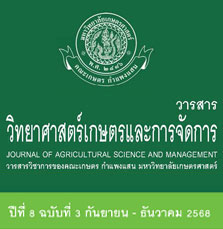ขวดลีโอนาร์ดส่งเสริมการเจริญเติบโตของข้าวฟ่าง การครอบครองรากและการสร้างสปอร์ของราอาร์บัสคูลาร์ไมคอร์ไรซา
คำสำคัญ:
เชื้อราไมคอร์ไรซา, ขวดลีโอนาร์ด, ระบบการให้น้ำพืชบทคัดย่อ
ศึกษาวิธีการให้น้ำแบบต่างๆ สำหรับระบบการปลูกพืชอาศัยที่มีผลต่อความอุดมสมบูรณ์ของเชื้อราอาร์บัสคูลาร์ไมคอร์ไรซา (AMF) จากการผลิตหัวเชื้อกระถางภายใต้โรงเรือน โดยใช้ข้าวฟ่างเป็นพืชอาศัย วางแผนการทดลองแบบสุ่มสมบูรณ์ (CRD) จัดสิ่งทดลองแบบแฟคทอเรียล จำนวน 2 ปัจจัย 3 ซ้ำ โดย ปัจจัยที่ 1 คือ ชนิดของเชื้อราไมคอร์ไรซา 4 สายพันธุ์ ได้แก่ Rhizoglomus aggregatum, Claroideoglomus etunicatum, Funneliformis geosporum and Rhizoglomus irregularis ปัจจัยที่ 2 คือ วิธีการให้น้ำ 3 กรรมวิธี ได้แก่ การรดน้ำ การใช้น้ำหยด และการใช้ขวดลีโอนาร์ด วิเคราะห์การเจริญเติบโตของข้าวฟ่าง การครอบครองรากและสปอร์ไมคอร์ไรซา ผลของการใช้ขวดลีโอนาร์ด แสดงให้เห็นว่าความสูงข้าวฟ่างมีความสูงเฉลี่ยสูงสุดและมีน้ำหนักแห้งสูงสุดสูง การครอบครองรากและจำนวนสปอร์ของอาร์บัสคูลาร์ไมคอร์ไรซาที่มีการใช้ขวดลีโอนาร์ดมีค่าสูงขึ้นอย่างมีนัยสำคัญเช่นกัน R. aggregatum และ F. geosporum มีการครอบครองรากข้าวฟ่างสูงที่สุด (64.24 และ 61.71 เปอร์เซ็นต์ ตามลำดับ) R. aggregatum มีระดับการผลิตสปอร์สูงสุด (33.13 สปอร์ต่อกรัม) การใช้ขวดลีโอนาร์ดมีผลทำให้รา C. etunicatum และ R. irregularis มีการครอบครองรากต่ำกว่า (20.51 และ 30.46 เปอร์เซ็นต์ ตามลำดับ) และเมื่อใช้ขวดลีโอนาร์ดทำให้จำนวนสปอร์ของไมคอร์ไรซา R. aggregatum และ F. geosporum มีมากกว่าของ C. etunicatum และ R. irregularis ดังนั้น ระบบการให้น้ำโดยใช้ขวดลีโอนาร์ดให้ความชื้นและสารอาหารคงที่ร่วมกับสายพันธุ์ AMF จึงส่งผลต่อการครอบครองรากและสปอร์ของหัวเชื้อ
เอกสารอ้างอิง
Akhtar, M.S. and Z.A. Siddiqui. 2010. Effects of AM fungi on the plant growth and root-rot disease of chickpea. American-Eurasian Journal of Agricultural & Environmental Sciences 8: 544-549.
Asher, C. 1975. Plant Nutrition I Practical Notes. Department of Agriculture and Fisheries Qld. Australia, 35 p.
Augé, R.M. 2001. Water relations, drought and vesicular-arbuscular mycorrhizal symbiosis. Mycorrhiza 11: 3-42.
Augé, R.M. 2004. Arbuscular mycorrhizae and soil/plant water relations. Canadian Journal of Soil Science 84(4): 373-381.
Begum, N., C. Qin, M.A. Ahanger, S. Raza, M.I. Khan, M. Ashraf, N. Ahmed and L. Zhang. 2019. Role of arbuscular mycorrhizal fungi in plant growth regulation: implications in abiotic stress tolerance. Frontiers in Plant Science 10: 1068.
Deepika, S. and D. Kothamasi. 2015. Soil moisture–a regulator of arbuscular mycorrhizal fungal community assembly and symbiotic phosphorus uptake. Mycorrhiza 25: 67-75.
Doussan, C., L. Pagès and G. Vercambre. 1998. Modelling of the hydraulic architecture of root systems: an integrated approach to water absorption—model description. Annals of Botany 81: 213-223.
Duponnois, R., A. Colombet, V. Hien and J. Thioulouse. 2005. The mycorrhizal fungus Glomus intraradices and rock phosphate amendment influence plant growth and microbial activity in the rhizosphere of Acacia holosericea. Soil Biology Biochemistry 37: 1460-1468.
Feldmann, F. and E. Idczak. 1992. Inoculum production of vesicular-arbuscular mycorrhizal fungi for use in tropical nurseries, pp. 799-833 In: J. Norris, D. Read, A. Varma (Eds). Techniques for Mycorrhizal Research Methods in Microbiology. Academic Press, London.
Finlay, R.D. 2008. Ecological aspects of mycorrhizal symbiosis: with special emphasis on the functional diversity of interactions involving the extraradical mycelium. Journal of Experimental Botany 59: 1115-1126.
Gerdemann, J. and T.H. Nicolson. 1963. Spores of mycorrhizal endogone species extracted from soil by wet sieving and decanting. Transactions of the British Mycological Society 46: 235-244.
Guo, W., R. Zhao, W. Zhao, R. Fu, J. Guo, N. Bi and J. Zhang. 2013. Effects of arbuscular mycorrhizal fungi on maize (Zea mays L) and sorghum (S. bicolor L Moench) grown in rare earth elements of mine tailings. Applied Soil Ecology 72: 85-92.
Hillock, D. and D. Needham. 2006. Houseplant Care. http://osufacts.okstate.edu (retrieved: September 1, 2023) Jin, H., J.J. Germida and F.L. Walley. 2013. Impact of arbuscular mycorrhizal fungal inoculants on subsequent arbuscular mycorrhizal fungi colonization in pot-cultured field pea (Pisum sativum L.). Mycorrhiza 23: 45-59.
Kokkoris, V. and M. Hart. 2019. In vitro propagation of arbuscular mycorrhizal fungi may drive fungal evolution. Frontiers in Microbiology 10: 2420.
Kumar, P. and M.H. Fulekar. 2019. Mycorrhizal soil development using Sorghum bicolor for rhizospheric bioremediation of heavy metals. Bioscience Biotechnology Research Communications 12: 688-697.
Leonard, L.T. 1943. A simple assembly for use in the testing of cultures of rhizobia. Journal of Bacteriology 45: 523-527.
Liu, R.C., Z.Y. Xiao, A. Hashem, E.F. Abd–Allah, Y.J. Xu and Q.S. Wu. 2021. Unraveling the interaction between arbuscular mycorrhizal fungi and Camellia plants. Horticulturae 7: 322.
Mahmood, I. and R. Rizvi. 2010. Mycorrhiza and organic farming. Asian Journal of Plant Science 9: 241.
Martin, S.L., S.J. Mooney, M.J. Dickinson and H.M. West. 2012. The effects of simultaneous root colonisation by three Glomus species on soil pore characteristics. Soil Biology Biochemistry 49: 167-173.
Meyer, M., S. Bourras, J. Gervais, K. Labadie, C. Cruaud, M.H. Balesdent, and T. Rouxel. 2017. Impact of biotic and abiotic factors on the expression of fungal effector-encoding genes in axenic growth conditions. Fungal Genetics and Biology 99: 1-12.
Mukerji, K.G. 1996. Concepts in mycorrhizal research. Springer Science and Business Media, London, 39 p.
Mullette, K. J. 1976. Mallee and tree forms within Eucalyptus species. Doctoral dissertation, University of New South Wales Sydney.
Phillips, J.M. and D. Hayman. 1970. Improved procedures for clearing roots and staining parasitic and vesicular-arbuscular mycorrhizal fungi for rapid assessment of infection. Transactions of the British Mycological Society 55: 158–IN118.
R Core Team. 2018. R: A language and environment for statistical computing. R Foundation for Statistical Semananda, N.P., J.D. Ward and B.R. Myers. 2018. A semi-systematic review of capillary irrigation: The benefits, limitations, and opportunities. Horticulturae 4: 23.
Shukla, A., A. Kumar, A. Jha and V. Tripathi. 2010. Effect of soil moisture on growth and arbuscular mycorrhizal colonization of crops and tree seedlings in alfisol. Indian Phytopathology 63: 411.
Shukla, A., A. Kumar, A. Jha, O. Salunkhe and D. Vyas. 2013. Soil moisture levels affect mycorrhization during early stages of development of agroforestry plants. Biology and Fertility of Soils 49: 545-554.
Silva, E.M., L.C. Maia, K.M.S. Menezes, M.B. Braga, N.D. Melo and A.M. Yano-Melo. 2015. Water availability and formation of propagules of arbuscular mycorrhizal fungi associated with sorghum. Applied Soil Ecology 94: 15-20.
Silva, F.S.B., A.M. Yano-Melo, J.A.C. Brandão and L.C. Maia. 2005. Sporulation of arbuscular mycorrhizal fungi using Tris-CHl buffer in addition to nutrient solutions. Brazilian Journal of Microbiology. 36: 327-332.
Smith, S.E. and D.J. Read. 2010. Mycorrhizal Symbiosis. Academic press, New York, 787 p.
Wang, F., Y. Sun and Z. Shi. 2019. Arbuscular mycorrhiza enhances biomass production and salt tolerance of sweet sorghum. Microorganisms 7: 289.
Watts‐Williams, S.J., A.R. Gill, N. Jewell, C.J. Brien, B. Berger, B.T. Tran, E. Mace, A.W. Cruickshank, D.R. Jordan, T. Garnett and T.R. Cavagnaro. 2022. Enhancement of sorghum grain yield and nutrition: A role for arbuscular mycorrhizal fungi regardless of soil phosphorus availability. Plants, People, Planet 4(2):143-156.






